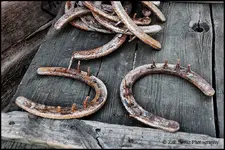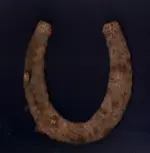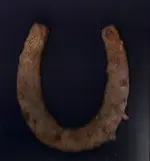Looks like you have a hind shoe with heel caulks, (corks). I don't really understand your question regarding the nails being "hammered back." When the shoe is nailed onto the foot, the tips of the nails come out of the hoof wall, and are "clinched," bent over and pounded down tight. On a brand new shoeing job, the nail heads stick down below the bottom of the shoe. Those nail heads quickly wear down even with the shoe. The United States Army required a horse shoe to be replaced every 6 weeks, reset once or twice, then when worn to much a new shoe was used. That's ideal. What happens in real life. Well, for one reason or another the horse could accidentally pull the shoe. Lots of times shoes are left on to long, sometimes so long the hoof grows long and breaks up, and the shoe comes off. Sometimes when that happens the shoe is held on by one or two nails for awhile, and it twists around, and the horse bends the nails over flat by stepping on them. Let your imagination run wild, there are lots of normal reasons for the nails on a lost shoe to be bent over. When you say pounded out, on a lost shoe that's not what happens, some nails are in the hole tight and stay, others will come loose and back out, only to be caught by the clinch and they stay with the shoe. If the shoe has been left on to long, some of the nails might rust off and just leave the head in the shoe, and some will come out leaving the hole. Here are a couple of shoes that have been pulled off by the farrier. He would have used a tool called a "clinch cutter," and either straightened the clinch out, or cut it off. Then the shoe was pulled with a tool with the unique name of "pull offs."
If the farrier is going to reuse the shoe, he'd drive the nails out, but if he wasn't going to reset it, then he'd toss it in the pile of used shoes just like that, at least that's what I did.









